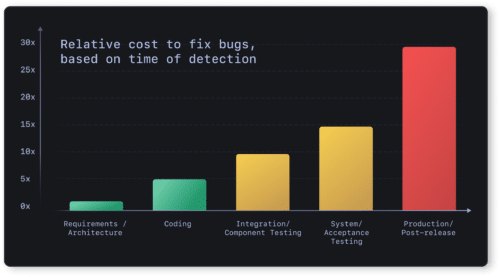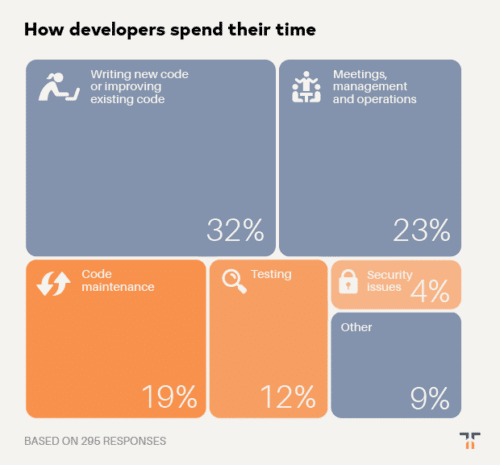On average, businesses in the tech industry spend nearly a quarter of their IT budget on quality assurance and testing. But this is low compared to a few years ago when tech companies spent nearly a third.
The reason for the drop? Cost.
Unfortunately, saving money upfront tends to cost companies more in the long run: Customers are less tolerant to slow apps, data insecurity, software errors, and overall bad customer experience (CX). And gaining that trust back can be costly.
Without proper quality control, there’s no way to guarantee a successful product, happy customers, and fewer bugs. That’s why performing quality assurance throughout the software development life cycle is crucial.
What Is Software Quality Assurance (SQA)?
Software quality assurance ensures that a program meets the company’s and industry’s standards and works as intended.
Software quality assurance varies greatly depending on the type of software and budget. Still, it pulls from various quantitative and qualitative research methods, like surveys, trials, historical data, and case studies.
Software quality assurance also takes into account industry best practices, such as:
- Focus on a results-oriented process. A results-oriented agile practice leads to more robust and stable software. Start by setting attainable targets and moving to larger goals when you’ve met them.
- Formulate an actional management plan. A software development management plan that maps out all necessary internal policies, processes, and compliances. For instance, health industry software should also followS. Food and Drug Administration (FDA) and Health Insurance Portability and Accountability Act (HIPAA) laws.
- Review and audit the quality assurance process. There’s almost always room for improvement. Ask yourself, “What can be done better? How can we improve efficiency? Is there a step in the process that needs to be addressed?”
- Use a multi-testing process. The more tests, the better. You’ll cover more bases, find more issues, and gain more insight into customer behaviors with multiple testing techniques. (Plus, you’ll save money in the long run.)
- Perform postrelease QA. The average company releases software with 15% bugs — but the best only releases with 5%. This is the importance of QA in the postrelease phase: Combine software testing and user bug reports to refine the software as you upgrade to meet the changing customer needs.
While best practices may seem subjective, these are qualities that increase a company’s reputation and customer experience. Of course, the quality assurance process differs from company to company, but it’s a procedure that should never cut corners for several reasons.
Reason #1: Provides a Better CX
Applications designed with the customer’s journey in mind have been shown to have better retention rates, which is vital in today’s day and age: More than ever before, customers are impatient and expect quality products and easy usability. Keep your product customer-focused through proper QA, and you’ll see how quickly your membership will grow.
Reason #2: Creates a Competitive Product
The need to create a competitive product is not news, but it is still relevant. If a product performs better or is cheaper than yours, customers are more likely to opt for that instead.
But what if you could create a never-been-seen product, is affordable (or free!), and works beyond expectations? That’s what proper software quality assurance testing will get you.
Reason #3: Meets Industry (and Company) Standards
Standards aren’t just about doing what’s expected: They’re also about complying with security needs and safety laws that protect companies and customer information.
For example, all American businesses are required not to do business with anyone on the OFAC Sanctions List — but part of the challenge is recognizing red flags and fool-proofing your software.
Software testing and quality control will help prevent accidental leaks and compromises, saving money and upholding your company’s reputation.
What Are Company Standards?
Company standards refer to an organization’s values, benchmarks, and beliefs. Within the IT realm, this might be something like:
- Meeting $1 million in revenue next year
- Launching an app with less than two rounds of post-SQA
- Processes like relying on an external QA team
Goals like these are essential because everything comes down to user experience (UX). That’s because the average consumer is impatient: 62% of people will uninstall an app if it crashes, freezes, or has bugs.
Take the fictional app creator, Mobility, for example. Their mobile game crashes whenever a user reaches the sixth level. Nearly one thousand players quit and eventually uninstalled the app. If Mobility had performed QA regularly or had the resources to perform an update, they wouldn’t have lost so many players.
What Are Industry Standards?
Industry software quality assurance standards are designed to guide software companies in developing high-quality, safe, reliable, and user-oriented software.
Therefore, industry standards guide the processes undertaken during the software development process to ensure consistently excellent products. Here are a few industry standards that software companies should always follow:
The Age-Old Debate: Internal vs. External Software Assurance Testing
If you’re a small company or want to save money, you’ve probably considered performing in-house tests rather than working with a third-party QA expert. At first glance, the cost is a significant factor: You may save more money upfront if you keep it in-house.
However, this isn’t true. It’s a rosy view in an attempt to save money. The truth is that your company will spend more money fixing bugs postrelease.
Unpredictability is in the name of the software development game. What happens when you need to perform post-QA? Or if there are bugs you can’t identify and fix? You’ll lose customers, and your reputation will be tainted, costing you more than proper QA.
A third-party QA expert helps you save time and money by releasing highly competitive products. Let’s dive into what a trusted resource can bring to your product.
Benefit #1: Can Perform Multiple Tests
On the surface, there are two types of quality control testing: Manual and automatic. But within these are dozens of subtypes that perform different tasks and identify issues.
For example, if you want to compare two layouts and see which performs better, then you need A/B testing. If you want to identify the triggers that make users exit your app, then you need load testing. If you want to see how many users can use your online product at once, then you need stress testing.
The question becomes: Do you know how to perform these tests, read their results, and implement the proper changes? The good news is that third-party QA experts do.
Benefit #2: Save Your Development Team Time
Working with outside software quality assurance professionals means your software product gets tested throughout the entire implementation process. In turn, this will save your internal team time.
In fact, one study found that by identifying defects early on (prerelease), 22% less time was spent on unplanned postrelease work. This gave the development team 29% more time on new, value-adding work.
In short, a third-party tester means time-consuming issues aren’t bogging down your team. Imagine what you could do with all this extra productivity space.
Benefit #3: Stay Up-to-Date On Latest Trends
The tech industry isn’t slowing down.
Take this study by The CEO Magazine, which observed at least ten upcoming trends for the next decade. One trend says there will be a big focus on QA and testing thanks to millennial expectations. Another predicts that security needs will blossom, too, because 70% of devices in the IoT are growing increasingly vulnerable.
With this extra set of eyes, your development team only spends their time honing software development skills — while a third party expertly works on the latest in testing, better guaranteeing a good UX and trusted security.
The Software Quality Assurance Process
More often than not, the answer to several common problems lies in quality assurance. So it comes as no surprise that this means software quality assurance processes are usually quite extensive.
In most cases, the software quality assurance process follows the Deming cycle (or the PDCA Cycle).
This four-step process is a continuous quality improvement method that follows four main stages to create top-notch products: Plan, Do, Check, and Act.
Step #1: Analyze, Plan, and Design Tests
Quality assurance begins with requirements analysis. QA experts help formulate, define and analyze software requirements to reduce or prevent instances that can cause bugs, non-functionality, and non-compliance to set industry standards.
Involving software quality assurance experts from the initial stage improves the software development team’s efficiency. Without QA, software development teams spend a third of their time improving code and fixing bugs.
The development team then creates a software quality assurance plan based on the decisions made during requirements analysis. The software quality assurance plan is critical as it is when you develop a software testing strategy, the scope of testing, testing tools to be used, project budget, acceptable timelines, and duty allocation.
The quality assurance team uses all gathered information to design test scenarios that will ensure the integrity of the software. The aim is to detect all serious errors and formulate a cost-effective testing approach by minimizing the number of tests needed to certify software health.
Step #2: Develop and Test the Software
Test execution begins at the lowest stage: The unit level. Software developers are responsible for this because unit tests inform them if they’ve developed the software correctly.
After this, the quality control experts pick up to run tests at UI and API levels. You can opt for manual procedures or automated tools.
XBOSoft conducts automated software testing — saving you time, reducing costs, and improving test coverage. We also have an effective defect management system, delivering defect-free software.
Step #3: Retest and Modify the Software
All defects and anomalies detected after the first test must be solved — and then more tests are run to identify issues that weren’t detected the first time. Additionally, any problems created after solving the existing issues are detected. Retests run continuously until all issues are weeded out.
Step #4: Implement Final Changes (And Stay Up-to-Date)
Release test running is the last stage of software quality assurance before the software is rolled out. The software product is assessed to certify that it’s ready to be released.
Finally, the software’s efficiency, functionality, usability, portability, reliability, and maintainability are evaluated. Any changes or updates are implemented through frequent postrelease testing.
Conclusion
Software quality assurance should be an integral part of your software development process. The benefits — integrity, functionality, safety, and scalability to meet the ever-changing customer demands — make software quality assurance important to any software or app.
But not just anybody can do it. Seasoned IT experts will tell you that outsourcing software quality assurance services from a dedicated team with specialized training is the best option because it exposes you to a better chance of achieving better CX, creating a competitive software product, and staying up-to-date on industry standards.
That’s where XBOSoft comes in. XBOSoft is your best bet at getting the most experienced QA experts who use multi-testing strategies to ensure the highest software quality. Book your consultation today.






Leave A Comment